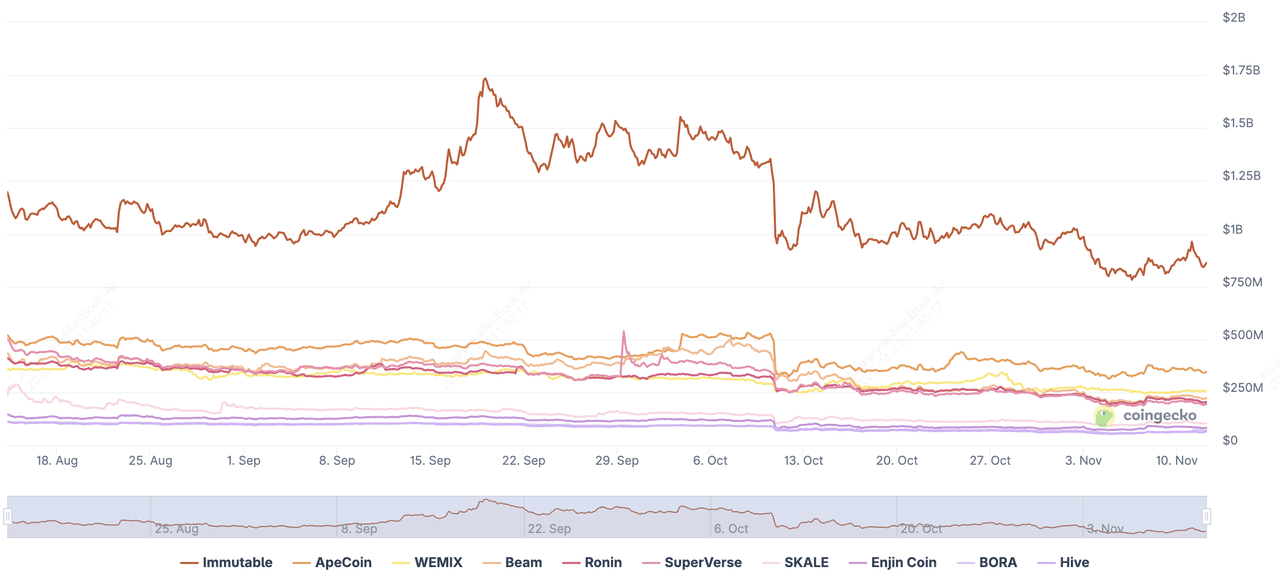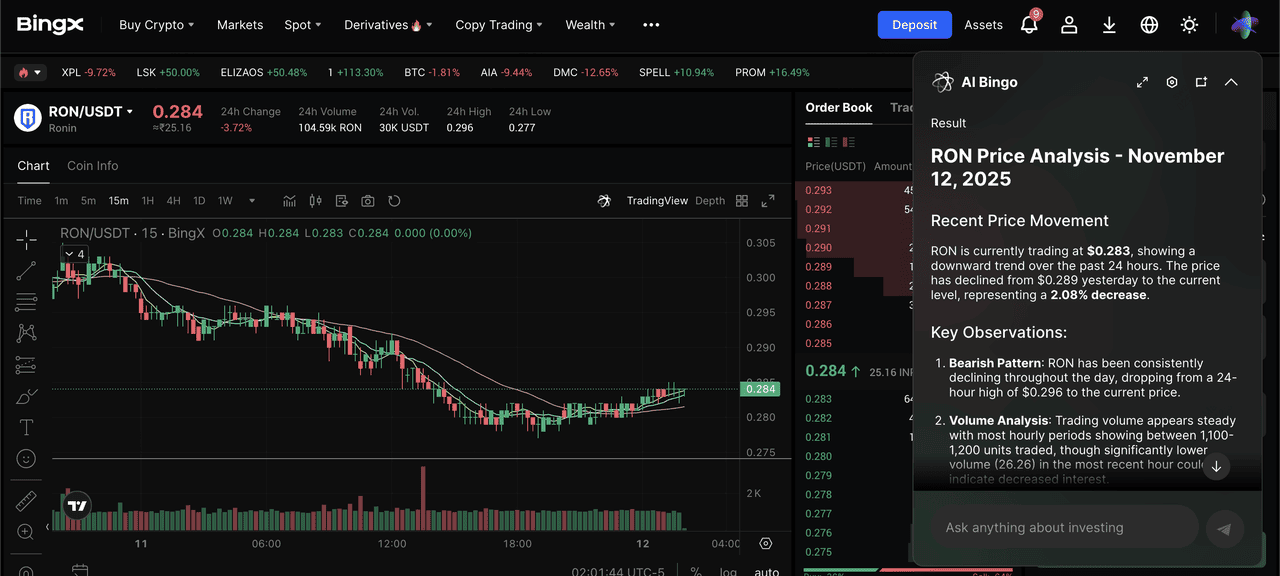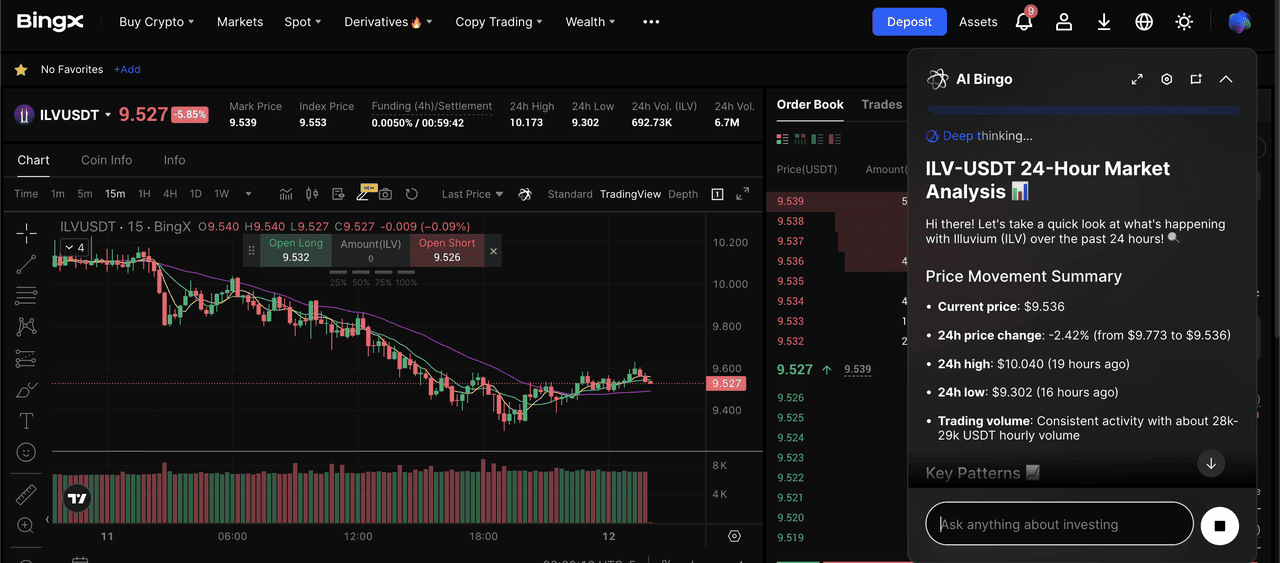Web3 gaming continues to lead all of crypto in real blockchain usage. Even in 2025’s weak market, gaming remained the #1 category in Web3, attracting 4.66 million daily active wallets in Q3, more than DeFi,
NFTs, and
SocialFi combined.
Low-fee chains built for games kept the sector alive:
opBNB led player activity,
Kaia exploded +229% quarter-over-quarter,
Ronin surged 55%,
Immutable zkEVM boosted trading for
Gods Unchained, and
WAX still processed a massive 687 million gaming transactions driven by
Alien Worlds.
In this guide, we explore the top gaming blockchains in 2025, how they work, why they matter, and which ones attract the most players and investors. You’ll learn about real adoption metrics such as daily active wallets, on-chain activity, and ecosystem strength to understand where Web3 gaming is heading next.
What Are Gaming Blockchains?
Gaming blockchains are specialized networks built to run Web3 games, NFTs, and play-to-earn rewards at high speed and low cost. Unlike traditional games where items stay locked on company servers, blockchain games store assets in your crypto wallet. This gives players true ownership; your characters, skins, or weapons exist as tokens you can sell, trade, or transfer anytime, even if the game shuts down.
These chains are optimized for real gameplay, where players perform hundreds of small actions like crafting, battling, mining, or claiming rewards. Networks such as opBNB, Ronin, Immutable zkEVM, WAX, Kaia, and
Sei process millions of transactions at fractions of a cent, making daily play affordable. In Q3 2025,
gaming remained the most active category in Web3 with 4.66 million daily active wallets, proving players are still logging in even during a weak market.
Gaming blockchains' market cap | Source: CoinGecko
The gaming blockchain market is now valued at roughly $2.9 billion, with more than $272 million in 24-hour trading volume. Popular titles like
World of Dypians,
Axie Infinity, Lumiterra, Alien Worlds, and Gods Unchained rely on these networks to run fast gameplay and open marketplaces. For beginners, gaming blockchains simply act as digital economies where players, not developers, control the assets they earn.
Why Are Gaming Blockchains Trending in 2025?
Gaming blockchains are trending in 2025 because real user activity remains strong, even while prices and market sentiment dropped. According to Q3 2025 reports, Web3 gaming attracted 4.66 million daily active wallets, making it the most used category in all of crypto. Chains like opBNB led with 1.05 million players, Kaia surged +229%, and Sei reached 802,000 daily wallets. Meanwhile, WAX processed a massive 687 million gaming transactions, proving that players are performing real in-game actions, not just logging in for rewards.
Top gaming blockchains of Q3 2025 | Source: DappRadar
The reason users keep returning is simple: low fees, fast gameplay, and real ownership of items. Players can earn NFT gear, trade assets on-chain, or transfer items between wallets, something traditional games can’t offer. Even as some projects shut down or tokens fell in price, games with strong economies, like World of Dypians, Axie, Lumiterra, Alien Worlds, and Gods Unchained, continued to grow. In short, 2025 shows that players value utility and fun more than hype, which is why gaming blockchains remain one of the most active sectors in Web3.
Top Gaming Blockchains to Watch in 2025
| Project |
Category / Purpose |
What It Powers |
Token Utility |
Why It Matters in 2025 |
| Render (RENDER) |
Decentralized GPU network |
AI, gaming, 3D rendering, metaverse |
Pay for GPU power, reward providers, governance |
Enables high-end visuals for Web3 games & VR worlds; cheaper than cloud GPUs |
| Immutable (IMX) |
Layer-2 gaming blockchain |
Gods Unchained, Guild of Guardians, 300+ games |
Staking, marketplace fees, ecosystem rewards |
Q3 2025 saw 507% surge in NFT trading after migration to Immutable zkEVM |
| The Sandbox (SAND) |
Metaverse world & game creator platform |
Land ownership, mini-games, virtual events |
Land purchases, creator rewards, staking |
SANDchain and credit-card onboarding aim to bring mainstream gamers |
| Gala (GALA) |
Gaming, film & music ecosystem |
Multiple GalaChain games, NFT items & collectibles |
Rewards, governance, marketplace functions |
Expanding into media + games; multi-chain support boosts access |
| Decentraland (MANA) |
Social metaverse platform |
Virtual land, events, concerts, buildings |
Land & asset purchases, in-world payments |
Hosts global festivals, creator tools, and seasonal events |
| Ronin (RON) |
Gaming-focused blockchain |
Axie, Lumiterra, Pixels, Machines Arena |
Gas fees, staking, validator rewards |
+55% wallet growth; deep player economies and NFT marketplaces |
| Yield Guild Games (YGG) |
Web3 gaming guild |
Scholarships, quests, rewards across games |
Governance, guild rewards, community incentives |
Onboards new players by providing starter NFTs & training |
| Moca Network (MOCA) |
Cross-game identity & social layer |
Partner games, creator hubs, loyalty programs |
Governance, rewards, cross-ecosystem utility |
Connects multiple games into one shared culture and identity layer |
| Illuvium (ILV) |
AAA RPG & auto-battler |
Illuvials, open-world exploration, PvP |
Governance, yield farming, game rewards |
High-end visuals, multi-mode gameplay, NFT battles and land |
| Beam (BEAM) |
Game publishing + asset interoperability |
Cross-game items, user worlds, NFTs |
Fees, governance, in-game currency |
Built by Merit Circle, powering multiple games and shared economies |
These networks dominate real adoption, on-chain gameplay, and developer interest.
1. Render (RENDER)
Render (RENDER) is the largest decentralized GPU-rendering network powering cinematic visuals for Web3 games, VFX, and metaverse worlds. As of November 2025, RENDER trades with a $1.21 billion market cap and $86.7 million in 24-hour volume, backed by a circulating supply of 518 million tokens. After rebranding from RNDR and deprecating its Polygon contract due to a security incident, the network upgraded holders to RENDER via its official portal. Render connects artists and AI projects to idle GPU providers, reducing rendering costs while scaling real-time 3D creation. With major use cases in gaming, digital art, and AI compute, and partnerships, including io.net, FedML, and Beam, it has become core infrastructure for high-fidelity Web3 visuals and metaverse development.
2. Immutable (IMX)
Immutable (IMX) is a leading Web3 gaming ecosystem powered by Immutable zkEVM, a low-fee Layer-2 secured by
Ethereum that hosts major titles like Gods Unchained, Guild of Guardians, and Shardbound, plus hundreds more in development. As of November 2025, IMX trades with a $862 million market cap, $34 million in 24-hour volume, and a circulating supply of 1.96 billion tokens. In Q3 2025, Gods Unchained NFT volume surged 507% after migrating to Immutable zkEVM, showing cheaper trading and higher liquidity for players.
IMX is used for gas,
staking, governance, marketplace fees, and rewards across the entire Immutable gaming network.
3. The Sandbox (SAND)
The Sandbox (SAND) is one of Web3’s largest virtual worlds, where players buy land, build custom experiences, and trade in-game assets as NFTs. As of November 2025, SAND trades with a $526 million market cap, $44 million in daily volume, and 2.61 billion tokens circulating. The platform continues hosting branded events with partners like Peaky Blinders, Cirque du Soleil, Attack on Titan, SSC Napoli, and Jamiroquai, attracting millions of visits across Season 6 experiences. In 2025, Animoca Brands increased strategic control and introduced SANDchain to improve on-chain logic and creator tools, while credit-card onboarding aims to pull mainstream gamers into the
metaverse, and not just crypto-native users.
4. Gala (GALA)
Gala (GALA) is a Web3 entertainment network spanning gaming, music, and film, using NFTs and tokens to give players and fans digital ownership. As of November 2025, GALA trades with a $470 million market cap, $69 million in 24-hour trading volume, and 46.5 billion tokens in circulation. Gala Games features multiplayer titles like Spider Tanks, Superior, Mirandus, and Last Expedition, while Gala Music and Gala Film host releases from artists such as Snoop Dogg, Macy Gray, and Earl Sweatshirt. With a multi-chain approach across Ethereum, BNB Chain, and GalaChain, players buy, trade, and use assets with lower gas fees and seamless in-game interoperability, making Gala one of the most active Web3 entertainment ecosystems in 2025.
5. Decentraland (MANA)
Decentraland (MANA) is a community-built virtual world where users buy land, explore digital cities, host events, and trade NFTs. As of November 2025, MANA trades with a $438 millin market cap, $26 million in 24-hour trading volume, and 1.91 billion tokens circulating. Despite metaverse hype cooling since 2022, Decentraland still runs branded concerts, festivals, conferences, and art events with thousands of monthly participants. In Q3 2025, it launched new creator tools for co-op building and announced Decentraland Music Festival 2025, boosting user retention and keeping the platform one of the most active open metaverse worlds in Web3.
6. Ronin (RON)
Ronin (RON) is a gaming-first blockchain used by top Web3 titles like Axie Infinity, Lumiterra, Pixels, and The Machines Arena, delivering fast gameplay and low gas fees for millions of players. As of November 2025, RON trades with a $204 million market cap, $4.3 million in daily volume, and 721 million tokens in circulation. In Q3 2025, daily active wallets jumped 55% to roughly 419,000, making Ronin one of the most active gaming chains. RON powers gas fees, staking, validator rewards, and in-game marketplace payments, while core on-chain loops like breeding, crafting, land gameplay, and NFT trading keep players economically engaged, making Ronin a durable gaming ecosystem rather than a single-game trend.
7. Yield Guild Games (YGG)
Yield Guild Games (YGG) is the largest Web3 gaming guild, helping players access top blockchain games through quests, scholarships, and starter NFT assetsm removing high entry costs for beginners. As of November 2025, YGG trades with a $77 million market cap, $27.8 million in daily trading volume, and 678 million tokens in circulation. The guild remains active across games like Axie Infinity, Pixels, and new RPG and shooter titles, offering structured play-to-earn paths, training, and community missions. The YGG token powers DAO governance, ecosystem rewards, and guild operations, making it one of the few Web3 communities consistently onboarding Web2 players into blockchain gaming at scale.
8. Moca Network (MOCA)
Moca Network (MOCA) is a gaming and culture-focused identity ecosystem backed by Animoca Brands, connecting 540+ partner games, NFT projects, and metaverse platforms under one shared profile and loyalty system. As of November 2025,
MOCA trades with a $289 million market cap, $6.7 million in daily volume, and over 7.1 billion tokens circulating. Instead of acting as a traditional game chain, Moca provides cross-game identity, reputation tracking, and rewards that follow users between platforms, helping onboard Web2 players through unified logins and privacy-preserving verification. With major adoption partners like MyAnimeList, SK Planet, and Openfire, the project positions itself as Web3’s social and identity layer rather than a single standalone game.
9. Illuvium (ILV)
Illuvium (ILV) is a high-end blockchain RPG and auto-battler built on Immutable zkEVM, featuring Unreal Engine visuals, open-world exploration, and over 150 collectible Illuvials that players can battle and trade as NFTs. As of November 2025, ILV trades with a $90.5 million market cap, $11.1 million in 24-hour volume, and 9.48 million tokens in circulation. The ecosystem spans three interoperable games, Overworld, Arena, and Zero, letting players farm resources, battle competitively, and earn NFT assets across modes. ILV is used for governance, staking, and rewards, positioning the franchise as one of Web3’s most advanced AAA gaming projects aimed at onboarding traditional gamers through polished gameplay and real digital ownership.
10. opBNB
opBNB is BNB Chain’s gaming-optimized Layer-2, offering sub-cent gas fees and high throughput for fast, on-chain gameplay. By November 2025, it consistently ranked among the most active gaming networks, frequently processing 7–10 million daily transactions with minimal congestion. Games like World of Dypians (WOD),
Seraph, Arena of Faith, and Pixelverse use opBNB for cheap NFT minting, item crafting, and marketplace trades, making gameplay affordable even for beginners. With low-cost transactions, developer grants, and smooth onboarding for Web2 users, opBNB has become one of the top chains for casual and mobile-style blockchain games.
How to Start Playing on Gaming Blockchains
If you’re new to Web3 gaming, the safest approach is to start small, try a game for free, and only invest once you understand how it works. Here’s a step-by-step method anyone can follow:
1. Pick a Blockchain Based on the Game You Want
Each gaming blockchain has its own most popular titles. Ronin is home to Axie Infinity, Lumiterra, and Pixels, while opBNB runs fast MMO-style games like World of Dypians, Seraph, and Pixudi with very cheap fees. Immutable zkEVM supports Gods Unchained and
Guild of Guardians, WAX powers Alien Worlds, and Kaia or Sei offer lightweight, mobile-friendly games for beginners.
If you’re unsure where to start, choose a free or low-cost game on opBNB or Ronin because onboarding is simple and gas fees are tiny.
2. Install the Right Wallet
You need a
crypto wallet to store items, sign game actions, and receive rewards. Ronin Wallet works for Axie and Lumiterra,
MetaMask or
Trust Wallet connects to opBNB games, Immutable Passport is the easiest option for Gods Unchained or GoG, and WAX Cloud Wallet is required for Alien Worlds. Most wallets offer email or Google sign-in, so you don’t need deep crypto knowledge to set them up.
3. Add Small Gas Funds
Every action on-chain, battling, crafting, claiming rewards, or trading, requires a very small network fee. You can buy chain tokens like
BNB,
ETH,
IMX,
WAXP, and
SEI directly on BingX, then transfer a few dollars’ worth to your wallet. For most games, $2–$5 of gas tokens is enough to play for days or even weeks.
4. Start Free or Low-Cost
Avoid buying expensive NFTs or premium gear on day one. Start with free characters, basic decks, or low-cost starter items so you can learn how the game works before spending real money. Once you understand the economy, how rewards, crafting, or marketplace trading works, you can decide whether it’s worth investing more.
Beginner Tip: If a game makes you connect a wallet but doesn’t require purchases, that’s usually a good sign. Games that demand big upfront spending or promise high passive income are riskier.
How to Buy Gaming Tokens on BingX
BingX lists top gaming tokens like IMX,
AXS,
GOG,
GMT,
TLM, WAXP, and RON; availability may vary by region. Beginners can use
BingX AI on the trading page to analyze risk levels, spot trends, and size positions more responsibly before buying.
Spot Trading to Buy and Sell Game Projects
RON/USDT trading pair on the spot market powered by BingX AI insights
Spot trading is the simplest way to buy and hold gaming tokens you want to use in a game.
1. Create and verify your BingX account, then log in.
2. Deposit funds using Apple Pay, bank transfer, card, or
P2P.
4. Choose how much to buy, confirm the order, and your tokens will appear in your Spot Wallet.
5. If you plan to use the token in a game, e.g., AXS on Ronin or IMX on Immutable, withdraw to the recommended wallet such as Ronin Wallet,
MetaMask, or Immutable Passport.
Futures Trading to Long or Short Gaming Coins
Futures allow you to long or short gaming tokens, but they carry higher risk because prices move quickly.
2. Use Isolated Margin so only that position’s funds are at risk.
3. Keep leverage low, around 2×–3×, because gaming tokens can spike or crash fast.
5. Treat futures as short-term speculation, not long-term holding.
Final Thoughts: Are Gaming Blockchains a Good Investment?
Gaming blockchains can be an exciting opportunity, but they’re still a high-risk investment. Millions of players continue to log in, new titles launch every month, and top games still generate millions in NFT trading volume. However, token prices remain volatile, some projects shut down, and not every game economy survives long-term. If you decide to invest, it’s safer to start small, play the game first, and only buy items or tokens once you understand how rewards, burning mechanisms, and in-game marketplaces actually work.
Despite the risks, 2025 proved that blockchain gaming is resilient. Networks like opBNB, Ronin, Immutable zkEVM, WAX, Kaia, Sei, and Somnia continue to grow because they offer fast transactions, low fees, and real ownership of items. If you’re exploring the space, begin with low-cost games, set up a secure wallet, and treat any earnings as a bonus, and not guaranteed income. With millions of active users, gaming blockchains remain one of the most active sectors in Web3 and could benefit significantly if the next crypto bull market drives new players and capital into the ecosystem.
Related Reading







